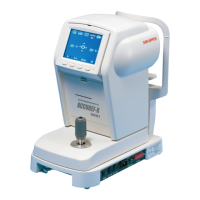
Do you have a question about the Shin-Nippon ACCUREF-K 9001 and is the answer not in the manual?
| Brand | Shin-Nippon |
|---|---|
| Model | ACCUREF-K 9001 |
| Category | Medical Equipment |
| Language | English |
Provides an overview of the manual's content and purpose for using the ACCUREF-K.
Introduces safety aspects and defines key safety symbols used in the manual.
Highlights essential warnings regarding instrument operation, electrical safety, and physical hazards.
Specifies optimal temperature and humidity ranges for instrument use and storage.
Enumerates all the items provided with the ACCUREF-K instrument.
Advises on proper handling, storage, and use of accessories to prevent damage or malfunction.
Details environmental factors such as lighting, dust, humidity, and stability for installation.
Covers instrument care, grounding, optical part cleaning, and repair policies.
Instructions for loading printer paper and preparing the chin rest liners.
Details how to connect the power cord and emphasizes proper grounding for safety.
Explains the meaning of various icons shown on the LCD monitor during standby.
Describes the functions of the switches located below the LCD monitor.
Details the usage of the joystick for controlling the measuring unit's movement.
Outlines the sequential steps involved in performing a measurement.
Guides on correct examinee positioning and the initial alignment steps.
Explains the specific alignment procedures for different measurement modes.
Details the steps for focus detection, involving reticle and joystick manipulation.
Describes how to achieve final focus and trigger the measurement.
Stresses the necessity of precise alignment for accurate results and recommends practice.
Explains how to interpret the values displayed for refractive and keratometry measurements.
Details the available printout formats (ALL, ECONO, OFF) and their data inclusion.
Illustrates sample printouts to help users understand the data presentation.
Guides on selecting P.K. mode and understanding the measurement guiding mark indicators.
Explains the meaning of the guiding mark's color changes for measurement progression.
Details the process of measuring peripheral corneal data at multiple points.
Illustrates the printout format for keratometry-peripheral measurements.
Explains how to enable IOL mode and what indicators to expect on screen.
Lists the various conditions that will automatically deactivate the IOL measurement mode.
Instructions on how to enter the menu and navigate between settings.
Shows the layout of the menu screen and explains the function of control switches.
Details settings for STEP, VD(mm), CYL, START, and REF measurement parameters.
Explains settings for keratometry units, print formats, and data screen display.
Covers configuration of near work distance, target brightness, and LCD contrast.
Details how to set power saving intervals and the volume of the measurement buzzer.
Explains configuration for optional functions, date format, and time adjustments.
Guides users on how to enter and print custom text messages.
Covers setting, displaying, and printing examinee identification numbers.
Details the setup for serial data transmission to an external computer.
Explains configuration for baud rate and character format in serial communication.
Details settings for parity check and stop bits in serial communication.
Guides on enabling and operating the auto start feature for automated measurements.
Instructions for activating and viewing saved measurement results on the screen.
Explains how to switch between data views and print the displayed information.
Describes the video terminal output for connecting external monitors.
Advises on room lighting, examinee posture, and creating a relaxed atmosphere.
Provides tips to avoid errors like eyelid interference and corneal debris for accurate readings.
Lists common error messages, their causes, and recommended corrective actions.
Details the steps for attaching a contact lens to the model eye holder for measurement.
Step-by-step instructions for replacing the printer paper roll.
Outlines checks and procedures for preparing the instrument for long-term storage.
Specifies the ideal environmental conditions for storing the instrument.
Explains how to check instrument accuracy using a model eye and tolerance values.
Provides instructions for correctly positioning the model eye for calibration.
Lists the detailed measurement ranges and accuracy specifications.
Details specifications for printer, monitor, dimensions, weight, and power requirements.